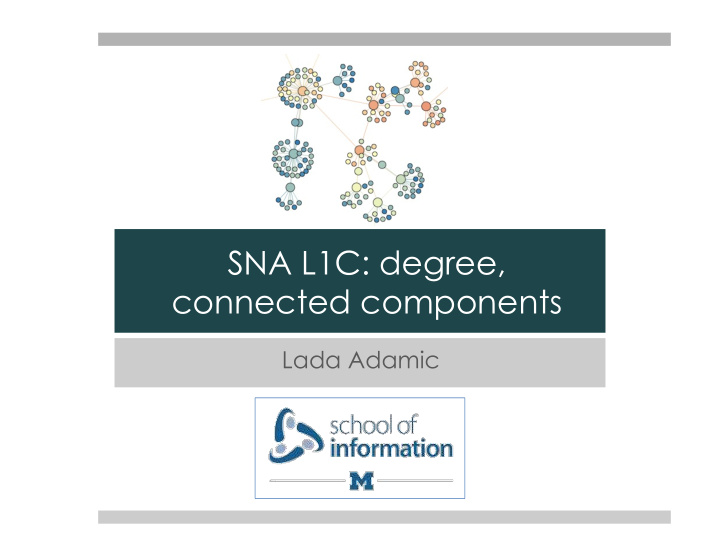



SNA L1C: degree, connected components Lada Adamic
Network elements: edges ! Directed (also called arcs, links) ! A -> B ! A likes B, A gave a gift to B, A is B � s child ! Undirected ! A <-> B or A – B ! A and B like each other ! A and B are siblings ! A and B are co-authors
Edge attributes ! Examples ! weight (e.g. frequency of communication) ! ranking (best friend, second best friend…) ! type (friend, relative, co-worker) ! properties depending on the structure of the rest of the graph: e.g. betweenness
Directed networks ! girls � school dormitory dining-table partners, 1 st and 2 nd choices (Moreno, The sociometry reader , 1960) 2 2 Louise 2 Ada Lena Adele Marion 2 1 1 Jane 2 Frances Cora 1 2 Eva Maxine 1 Mary 2 Anna Ruth Edna 1 Robin 1 Betty Martha 1 2 1 Jean 2 1 1 1 Laura Alice 1 2 Hazel Helen Hilda Ellen Ella Irene
Positive and negative weights ! e.g. one person trusting/distrusting another ! Research challenge: How does one � propagate � negative feelings in a social network? Is my enemy � s enemy my friend? sample of positive & negative ratings from Epinions network
Data representation ! adjacency matrix ! edgelist ! adjacency list
Adjacency matrices ! Representing edges (who is adjacent to whom) as a matrix ! A ij = 1 if node j has an edge to node i = 0 if node j does not have an edge to i ! A ii = 0 unless the network has self-loops ! A ij = A ji if the network is undirected, or if i and j share a reciprocated edge
Example adjacency matrix 2 0 0 0 0 0 3 1 0 0 1 1 0 A = 0 1 0 1 0 0 0 0 0 1 4 1 1 0 0 0 5
Edge list ! Edge list ! 2, 3 2 ! 2, 4 3 1 ! 3, 2 ! 3, 4 ! 4, 5 4 5 ! 5, 2 ! 5, 1
Adjacency lists ! Adjacency list 2 ! is easier to work with if network is 3 ! large 1 ! sparse ! quickly retrieve all neighbors for a node 4 5 ! 1: ! 2: 3 4 ! 3: 2 4 ! 4: 5 ! 5: 1 2
Computing metrics ! degree & degree distribution ! connected components
Degree: which node has the most edges? ? ? ?
Nodes ! Node network properties ! from immediate connections ! indegree indegree=3 how many directed edges (arcs) are incident on a node ! outdegree outdegree=2 how many directed edges (arcs) originate at a node ! degree (in or out) degree=5 number of edges incident on a node ! from the entire graph ! centrality (betweenness, closeness)
2 Node degree from matrix values 3 1 4 0 0 0 0 0 n 5 A ∑ ! Indegree = 0 0 1 1 0 ij A = j 1 = 0 1 0 1 0 0 0 0 0 1 example: indegree for node 3 is 2, which we obtain by summing the number of non-zero 1 1 0 0 0 entries in the 3 rd row n A ∑ 3 j j 1 = 0 0 0 0 0 n ∑ ! Outdegree = A ij 0 0 1 1 0 A = i = 1 0 1 0 1 0 example: the indegree for node 3 is 1, 0 0 0 0 1 which we obtain by summing the number of 1 1 0 0 0 non-zero entries in the 3 rd column n A ∑ i 3 i 1 =
Network metrics: degree sequence and degree distribution ! Degree sequence: An ordered list of the (in,out) degree of each node ! In-degree sequence: ! [2, 2, 2, 1, 1, 1, 1, 0] ! Out-degree sequence: ! [2, 2, 2, 2, 1, 1, 1, 0] ! (undirected) degree sequence: ! [3, 3, 3, 2, 2, 1, 1, 1] ! Degree distribution: A frequency count of the occurrence of each degree 5 ! In-degree distribution: ! [(2,3) (1,4) (0,1)] 4 ! Out-degree distribution: ! [(2,4) (1,3) (0,1)] frequency 3 ! (undirected) distribution: ! [(3,3) (2,2) (1,3)] 2 1 0 0 1 2 indegree
Is everything connected?
Connected components ! Strongly connected components ! Each node within the component can be reached from every other node in the component by following directed links B F G ! Strongly connected components C A ! B C D E ! A ! G H ! F H D E ! Weakly connected components: every node can be reached from every other node by following links in either direction ! Weakly connected components B F ! A B C D E G ! G H F C A H D ! In undirected networks one talks simply E about � connected components �
Giant component ! if the largest component encompasses a significant fraction of the graph, it is called the giant component
Recap ! Networks can be represented as matrices ! Usefull network metrics: ! degree and degree distribution ! connected components ! strong ! weak ! giant
Recommend
More recommend